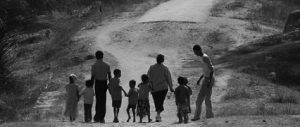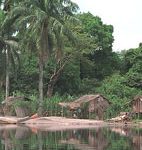The Kumeyaay people have learned to live with wind. Their lands, perched in the high desert some 70 kilometres east of San Diego, in far-southern California, are perpetually buffeted by gusts that rush down valleys and canyons, hurtling toward the Pacific Ocean. The gusts sometimes reach hurricane speeds, blasting the coast with hot desert air, forcing residents to seek refuge inland, like the forebears of today’s Kumeyaay did.
In the 1980s, leaders of the Native American – or American Indian — tribe wondered if their lands might make a good home for wind turbines, which were then beginning to dot the hills in nearby Palm Springs. “When wind developers proposed a wind farm on our lands, we listened,” says tribal chairwoman Monique LaChappa. “When we understood that we could not get the same return on invested capital as non-Indian developers, we agreed to support the development of Kumeyaay Wind I anyway, and leased our land and resources.”
So, in 2005, the tribe did something remarkable. It built what was then and remains the only commercial wind farm on tribal land in the United States. The turbines produce enough electricity to power the tribe’s administrative buildings, as well as 30,000 homes off the Campo reservation. The tribe’s second wind farm, Kumeyaay Wind II – expected to come online in 2012 — is a 160-megawatt project to be built in partnership with the local utility, San Diego Gas and Electric (SDGE), and Invenergy LLC.
The projects suggest a new direction for the country’s tribes, one supported by tribal advocates such as the Washington-based National Congress of American Indians (NCAI). “We want an energy future for tribes that is tribally driven,” says the organisation’s policy adviser, Jose Aguto.
The Kumeyaay wind farms should not be exceptional. Indian tribal lands cover almost 5% of the United States yet hold 10% of the country’s renewable energy resources. In his first address to tribal leaders, in December 2009, president Barack Obama noted that up to 15% of America’s potential wind-energy resources are on tribal lands. By US Department of Energy estimates, tribal lands hold solar energy potential equivalent to 4.5 times the national electricity consumption.
Despite these riches, America’s indigenous peoples remain woefully under-served. Many tribal reservations in the United States, especially those in the west and in Alaska, are remote, located far from major population centres and electricity transmission corridors. More than 14% of Indian households on reservations have no access to electricity, a rate about a dozen times higher than for the country at large.
Energy development is complicated by the unique legal status of tribal lands in the United States. In legal precedent dating to the 1830s, the 565 federally recognised tribes are considered sovereign nations having a government-to-government relationship with the United States. By definition, a federal Indian “reservation” is a permanent tribal homeland to which the federal government holds the land title in trust on the behalf of the tribe. Some 23 million hectares on 326 land areas are administered as federal Indian reservations (including pueblos, villages, missions, communities and other entities), spread across the United States but concentrated in the west.
American Indians and Alaska Natives do not pay federal or state income taxes on income from reservation lands, nor do they pay state sales taxes for transactions on the land.
In 2010, then-US senator Byron Dorgan of North Dakota – chairman of the Senate Committee on Indian Affairs — introduced the Indian Energy Promotion and Parity Act of 2010. The bill was an attempt to address many of the obstacles that had hampered renewable-energy development on tribal lands for decades. It identified three major barriers to developing renewable energy in Indian country: outdated laws and cumbersome regulations, lack of access to transmission grids and difficulty in obtaining financing and investment.
While such obstacles can hinder renewable-energy projects anywhere, in Indian country the bureaucracy is byzantine, the transmission lines impossibly distant (or non-existent), and the available financing a fleeting pittance.
Just after Dorgan issued a draft of his Indian energy bill in March 2010, the National Wildlife Federation released a report that underscored many of the same barriers to renewable energy production in Indian country. Especially onerous, the NWF found, are tax disincentives. Because tribes are exempt from federal income taxes, they are unable to take advantage of certain incentives, such as the investment tax credit equal to 30% of project cost. Investors also fear a hefty tax bill. States can assess taxes on non-Indian companies undertaking projects on tribal land; if tribes did likewise, investors would face double taxation.
Dorgan’s Indian energy bill was not approved, and a legislative fix is not likely to occur any time soon. Not content to wait for the US Congress to act, however, tribes are pushing ahead with the first wave of large-scale renewable-energy projects in Indian Country.
Nearly 100 tribal energy projects received US$14 million in grants from the energy department’s Tribal Energy Program from 2002 to 2007. The money largely funded preliminary assessment and planning. Much larger sums will be needed to actually build projects. More tribes are poised to join the Campo Kumeyaay Nation in doing just that.
The Pueblo of Acoma tribe, located on a high desert plateau 120 kilometres west of Albuquerque, New Mexico, intends to issue nearly US$7 million in Tribal Economic Development Bonds to build a 15-megawatt (MW) wind farm.
The Moapa Band of Paiutes, with partner K Road Moapa Solar LLC, is seeking federal approval to build a 350-MW solar photovoltaic farm on the tribe’s sun-drenched desert reservation about 50 kilometres north-east of Las Vegas, Nevada. Fortunately for the tribe, the project site is located just a kilometre from an electrical substation and transmission corridor.
To the south, the Navajo Nation wants to build an 85-MW wind farm at Big Boquillas Ranch, in the high-desert grasslands some 130 kilometres west of Flagstaff, Arizona. The project will bring much needed electricity to the reservation, as well as the power-hungry cities of the south-west – enough to serve 15,000 to 20,000 homes. A portion of the output will be reserved for the tribe, which will own a majority stake in the project. Of Indian households lacking electricity, the Navajo Nation accounts for 75%.
The Campo Kumeyaay Nation itself is transitioning from the role of landlord to owner of its renewable energy projects. With a US$60-million investment, the tribe will own a 20% share of its second wind farm. After 25 years of operation, the Campo Kumeyaay will take full ownership of both reservation wind farms.
Tribal chairwoman LaChappa says the moves are just the beginning. In the works is the creation of a Campo Renewable Energy Zone (CREZ). “The CREZ will enable us to develop new and exciting partnerships that build on our reputation and experience as a leader in renewable energy,” she says. Citing the early stage of the talks, LaChappa would not go into the details, but one of the first manufacturers to contact the tribe to learn more about the CREZ, she says, was a Chinese company.
Tribes are beginning to surmount the geographical, economic and legal obstacles that have long slowed renewable-energy development. What they want most, they and their advocates say, is a level playing field — the ability to pursue economic development, including clean-energy projects, on equal footing with state and local governments and private companies. In Barack Obama, tribes seem to have found a partner willing to make their issues a priority.
The Obama administration signaled its good-faith intentions most clearly last December, when the second White House Tribal Nations Conference took place. “We’re … breaking down bureaucratic barriers that have prevented tribal nations from developing clean energy like wind and solar power,” Obama told tribal leaders. “It’s essential not just to your prosperity, but to the prosperity of our whole country.”
In the same December 16 address, Obama endorsed the United Nations Declaration on the Rights of Indigenous Peoples, a move long sought by tribes. The same day, the White House also announced the establishment of the Office of Indian Energy Policy and Programs at the Department of Energy. Led by Tracey A LeBeau of the Cheyenne River Sioux Tribe of South Dakota, the office aims to more effectively engage tribal governments in national energy priorities and promote tribal energy development.
The following month, US energy secretary Steven Chu announced US$10 million for tribal renewable-energy and energy-efficiency projects. (This was in addition to US$250 million in economic development bonds allocated in February 2010 under the American Recovery and Reinvestment Act — the economic stimulus bill of 2009 — to 16 tribes, including the Campo Kumeyaay and Navajo Nations, partly for renewable energy projects.)
LeBeau and Chu hosted a Tribal Summit in Washington earlier this month and, in his remarks on May 5, Chu announced the formation of an advisory Indian Clean Energy and Infrastructure Working Group to promote collaboration between his department and tribes. Details are expected in the weeks ahead. LaChappa volunteered to join the new body. She termed it – and the leadership of Arun Majumdar, director of the Advanced Research Projects Agency-Energy (ARPA-E), the country’s only agency devoted to transformational energy research and development — “key to unlocking the potential of 21st-century technology on tribal lands – and bringing true innovation to a population that is currently one of the most underserved when it comes to innovation and technology.”
In the two months leading up to the summit, LeBeau criss-crossed the country, convening a series of tribal town meetings to seek consensus on ways to unlock energy development. Already, LeBeau says, “there are some clear areas of consensus about a few things – including a perceived overlap in what agencies are doing in the area of energy development. A desire by Indian Country is that our team seeks out a way to put the pieces of the federal puzzle together in a way that helps them to best leverage federal resources.”
Byron Dorgan retired from the US Senate in January 2011, leaving the fate of his Indian energy bill very much in doubt. “There were a lot of promising things in senator Dorgan’s bill that would have helped alleviate the obstacles to tribal renewable-energy projects,” according to Garrit Voggesser, manager of the NWF’s Tribal Lands Conservation Program. “Absent dealing with the tax disincentives, it’s going to be a challenging road to get more large-scale renewable-energy projects up on tribal lands.”
LeBeau says her office is working with other federal agencies to find solutions to the financing dilemma. “We do have new tools, which help address the issue of tribal equity participation in certain energy projects, but there is no one simple solution,” she notes.
“As a sovereign nation,” LaChappa emphasises, “we merely want to be on a level playing field with state and local governments when it comes to economic development, renewable energy and energy efficiency. We need equal access to financing, a seat at the planning table, and streamlined processes for leasing, rights of way and environmental review to seize the opportunity before us.”
“There’s a lot of work to be done,” adds Jose Aguto. “The Obama administration is working with us to overcome historic, generational obstacles.”
As Chu told the recent Tribal Summit: “By working together on energy issues, we can grow our economies and create good jobs, while increasing our security and protecting our planet.” He reminded the participants, in closing, of a familiar Native American proverb that he said reflects the stakes of the energy challenge ahead: “Treat the earth well. It was not given to you by your parents; it was loaned to you by your children. We do not inherit the earth from our ancestors; we borrow it from our children.”
Justin Gerdes is a freelance journalist based in California.
Homepage photo by Matt Ferguson shows, from left, Monique LaChappa, Steven Chu and Tracey LeBeau.


